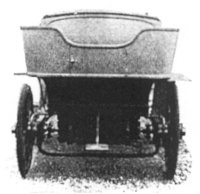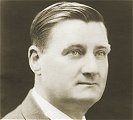The Parker Steam Car
From the Autocar. 7th December
1901
|

The steam car. Courtesy of the late Jim Boulton. |
Some little time since we were invited to inspect a
newly designed 10h.p. steam car, which was then nearing completion
in the works of the Wearwell Motor Co. of Wolverhampton, in
accordance with the designs and under the supervision of Mr. Thos.
Hugh Parker. |
The frame of this vehicle is formed of 2.5 inch channel steel, and is
8ft. 6in. x 3ft. over all. It is placed on semi-elliptical springs, 3ft.
6in. front and 3ft. 9in. back, the whole carried on 36in. artillery built
solid rubber-tyred wheels running on ball bearings. The engine, which weighs
3 cwt. complete is a 10 n.h.p. compound of the open launch type set in the
rear half of the frame, and driving the rear live axle through suitable
bevel gearing. The high pressure cylinder is 4in. bore, the low pressure
6in., and the stroke 4in. A specially adapted Joy's valve gear is used. A
jet condenser, with a special oil separator in combination, is fitted. The
water tank is placed in the centre of the frame, and the direct acting
circulating pump worked from cross head slide coupled directly thereto. The
engine bed plate carries the bearings for differential, gear and engine
crankshaft.
| In connection with the condensing apparatus are
500ft. of Loyal radiating tube, 250ft. of which is fixed in front
and 250ft. in rear of the vehicle below the frame. The bevel wheel
driven off engineshaft is strongly bolted round the differential
gear box, the gear within which is of large dimensions. The bevel
pinion on the crankshaft is of steel, while the bevel wheel which it
drives is of phosphor bronze. The boiler is of the flash type, set
forward of the dashboard beneath a motor bonnet, and its 300ft. of
tubing is of five eighths of an inch external and a quarter of an
inch internal diameter. It is fired by a specially designed burner
consuming heavy oil, and its working pressure is from sixty to one
hundred pounds per square inch. The oil tank has a capacity of
fifteen gallons, and the water tank already mentioned of eight,
gallons. |

Rear view. Courtesy of the late Jim Boulton. |
The bonnet which hides the boiler from view is of browned steel, with
brass mountings, the appearance being very handsome.
|

Another view of the car. Courtesy of the
late Jim
Boulton. |
The differential gear is of the three-star type
enclosed in an oil-tight phosphor-bronze case, with cast steel shaft
passing through sleeves, which are each entire, with their
respective brake drums and differential wheels, the whole being
carried complete on the engine bed. The bearings throughout are
large and long in proportion to the work they have to perform, while
their lubrication is amply provided for. Thrust blocks are provided
at the crankshaft bearings. |
The engine and gearing are fixed to the frame by three strong channel
iron slings, as also is the boiler, while the body of the vehicle, whatever
type be adopted, has only one connection with the mechanism of the car, and
that the union connecting up the oil supply from the oil tank before
mentioned, the oil tank being placed behind the driver's seat.
| To allow the engine and gear being carried upon the
frame supported on the springs, the driving axle is fitted with four
flexible raw hide connections, two inside brake drums next
differential gear, and two just inside driving axle spring bearings.
These raw hide connections give a pliability to the driving axle
after the manner of the Cardan driving axles on the De Dion
voiturettes.
The vehicle is more than amply supplied with brakes, having two
double-acting band brakes on road driving wheels, and two on
differential gear box, all four being actuated through Bowden
wires, each of one ton breaking strain, the differential brakes
being applied by pedal from footboard, and the road-wheel band
brakes by side lever. Worm and wheel steering (Ackermann type)
is provided. |

The engine with the body removed. Courtesy
of the late Jim Boulton. |

The side view of the generator and engine,
with the bonnet and body removed. Courtesy of the late Jim Boulton. |
In addition to the side brake lever, two other levers are set at the
right-hand side of the car; one for working the hand pump, and the other for
reversing the engine. A pedal is placed on the footboard, and by this steam
is arrested to the engine.
The body is of the tonneau type, we11 rounded, and excellently built. The
weight of the vehicle complete with oil and water tanks full approximates to
23 cwt.
|
|
The whole of the construction, erection, and body building has been
carried out at the Wearwell Motor Works by Mr. Parker, who is to. be
congratulated upon the design of so practical a vehicle.
Since we saw the car it has been put through its trial trips, and has, we
understand, behaved very well, the speed being easily controllable from one
to thirty miles an hour, the only thing requiring adjustment being the feed
pumps, and these are now having Mr. Parker's attention.
|

View from above with the body removed. Courtesy of the late Jim Boulton. |
 |
 |
Return to
Early Vehicles |
Return to
the Beginning |
|









